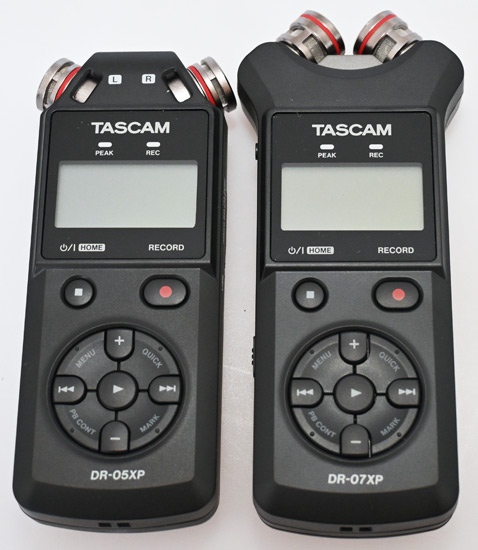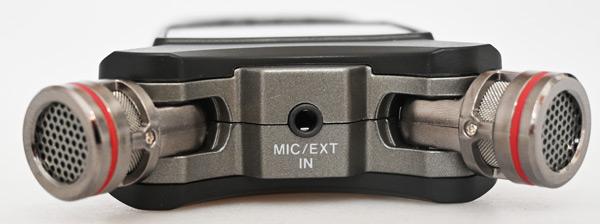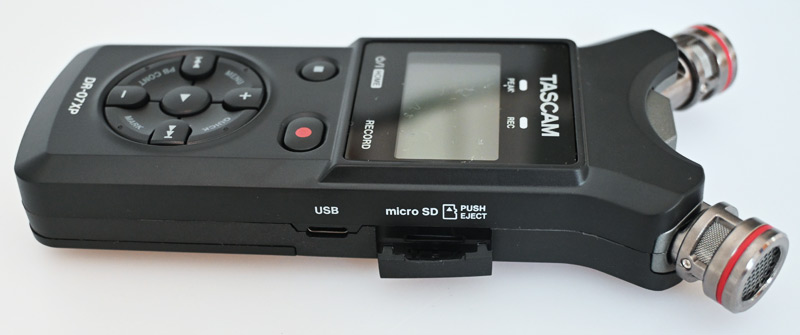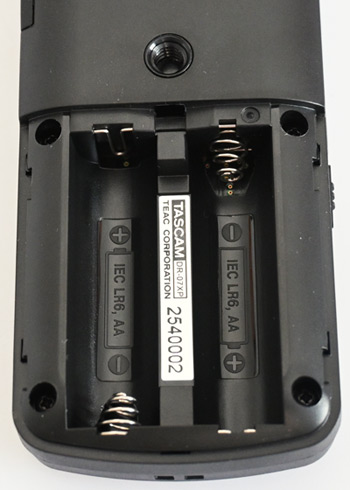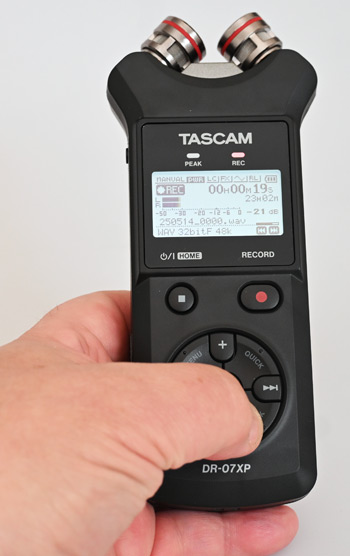Tascam DR-05XP / DR-07XP
Stereo audio field recorder with 32-bit float format
Author: Erol Ergün | Photos: Peter Kaminski, Erol Ergün (2)
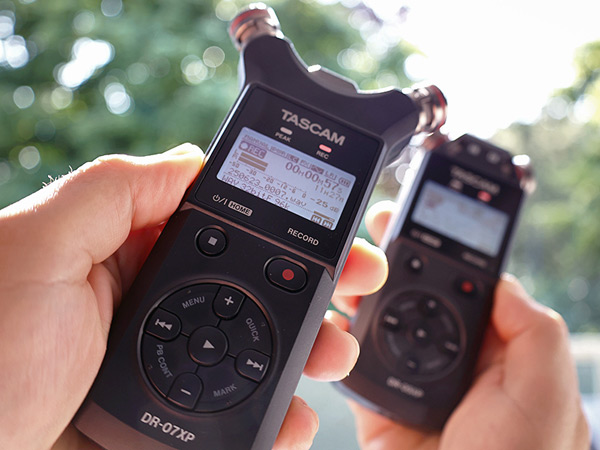
With the introduction of the latest generation of stereo audio recorders, Tascam has updated its already broad range of mobile recording devices. As successors to the acclaimed DR-05X and DR-07X recorders, the DR-05XP and DR-07XP now feature distortion-free recording using 32-bit float technology, and a sample rate of up to 96 kHz. In our test, we focus on the DR-07XP with foldable microphone capsules, as the two models differ primarily in their microphone technology.
Features
Like its predecessor, the DR-07XP has a sturdy black plastic housing weighing 184g (with batteries) and measuring 68mm x 160mm x 27mm (W x H x D) with the microphone capsules folded in. The electret condenser microphones have a cardioid polar pattern and can be folded out and in for AB or XY configurations. The DR-05XP is slightly more compact at 61mm x 142mm x 27mm (W x H x D) and slightly lighter with a weight of 174g including batteries. It features electret condenser microphones with fixed microphone capsules and omnidirectional polar patterns.
Incidentally, neither model has built-in data storage. Storage media in the form of microSD cards must be purchased separately to store recordings. As with other devices in this category, the upper limit for audio files is 2GB. Although a new file is created seamlessly for longer recordings, all files must be merged seamlessly during editing, which requires an additional step, for example, when editing video interviews.
As with its predecessors, there is a USB audio interface mode for connection to computers with Windows and Apple operating systems, including iOS. Connection to an Android device cannot be guaranteed due to different OS variants, but generally, it is possible as a USB audio device in Class Compliant mode, which we were able to verify in our test. While an ASIO driver is recommended for low latency recording on Windows, standard drivers work for macOS and iOS. Tascam provides the ASIO driver free of charge in the download section of its website.
Both models can process two audio tracks simultaneously with resolutions of up to 96 kHz and a 32-bit word length: You can choose between 44.1 or 48 and 96kHz with bit rates of 16 or 24bits or 32-bit floating point in linear PCM format WAV/BWF, or 44.1 and 48kHz with bit rates of 32, 64, 128, 192, 256, and 320kBit/s in MP3 format. The frequency range for recordings is 20 Hz to 20kHz (+0/-1dB) at a sample rate of 44.1kHz, at 48kHz it is 20Hz to 22kHz (+0/-1dB), and at 96kHz it is 20Hz to 40kHz (+0/-1.5dB) with a total distortion (THD+N) of ≤0.01% in accordance with JEITA standard CP-2150. Levels up to 125dB SPL can be processed.
Tascam has integrated a whole range of features into both devices that should appeal to a wide audience. For example, the slate function can be used to record a clap signal at the beginning and/or end of a recording to mark the corresponding takes during video editing. In addition to a switchable reverb with six presets for two large, medium, and small reverb rooms, a limiter and a compressor are also available for automatic level control of loud and soft audio signals. For practice, there is an overdub recording function and a loop function that allows not only the repeated playback of entire recordings but also the endless playback of sections marked with markers.
There is also a high-pass filter with a selectable cutoff frequency of 40, 80, 120Hz and now, on the P model, an additional 220Hz. Furthermore, recordings can be played back at half or double speed without changing the pitch, which can be particularly useful when reviewing interviews or your own memos. As the name implies, there is also a tuning function that allows musical instruments to be tuned using microphone recording. Practical features such as two seconds of pre-recording, delayed recording start, and auto-recording when a level value is exceeded round off the range of useful tools for uncomplicated and fast recording sessions.
Connections and operation
Both devices have identical connections and controls. A detailed, multilingual manual is included. The recorders feature a high-contrast, backlit monochrome display with a screen diagonal of 45mm and a resolution of 128 x 64 pixels, makings all parameters easy to read - even in bright environments. Below this are two multifunction switches for switching the device on and off and indicating the recording status, as well as circular controls for navigating menus and adjusting parameters. As usual with Tascam, the menu navigation can be switched between English, German, French, Spanish, and Italian.
On the front panel, between the microphone capsules, there is a 3.5mm stereo jack input socket for external signals or stereo microphones.
On the left side, there is a line or headphone output in the form of a 3.5mm stereo jack, also made of plastic, as well as a hold switch to activate the key lock to prevent accidental operation of the controls.
On the right side, the USB-C port for connecting to a computer, tablet, or smartphone has been modernized compared to its predecessor, along with the optionally available power supply (PS-P520U). The microSD card slot is located next to it. Unlike its predecessor with 128GB, storage media in microSD, microSDHC, and microSDXC formats with up to 512GB can be used, which is very practical given the high data volume of mobile recordings at the highest resolution of 32-bit/96 kHz. Incidentally, Tascam provides a list of currently supported storage media as a PDF document on its website.
On the back, there is a 1/4-inch plastic tripod socket, a mono speaker with 0.3 watts of power, and a battery compartment for two alkaline batteries or NiMH rechargeable batteries (type AA).
In practice
As with its predecessor and other multitrack devices in the Tascam family, the operation is well thought out and easy to understand without having to study the user manual, which can be downloaded online in English. Thanks to the well-structured menu navigation and button layout, the DR-07XP can be operated easily with one hand. I found the quick button very helpful, as it allowed me to edit important parameters directly in context, depending on the menu.
The backlit display is readable even in sunlight, and the buttons have a clear pressure point. When setting markers during the recording, the button sounds were audible due to the microphone capsules not being decoupled from the housing, as were other touches of the housing. This made it quite difficult to hold the device during an interview without picking up noise. A table or boom stand is recommended here.
Speaking of tripods: thanks to its versatility, the DR-07XP is ideal for videos, effect recordings, or musical recordings. The 1/4-inch tripod thread integrated into the housing is made of plastic. A metal version would be preferable here. At 0.3 watts, the speaker is relatively quiet and can only be used in low-noise environments. A slight noise was noticeable on the line-out. The headphone output had no problem driving the venerable Beyerdynamic DT-770 headphones with 250 ohms.
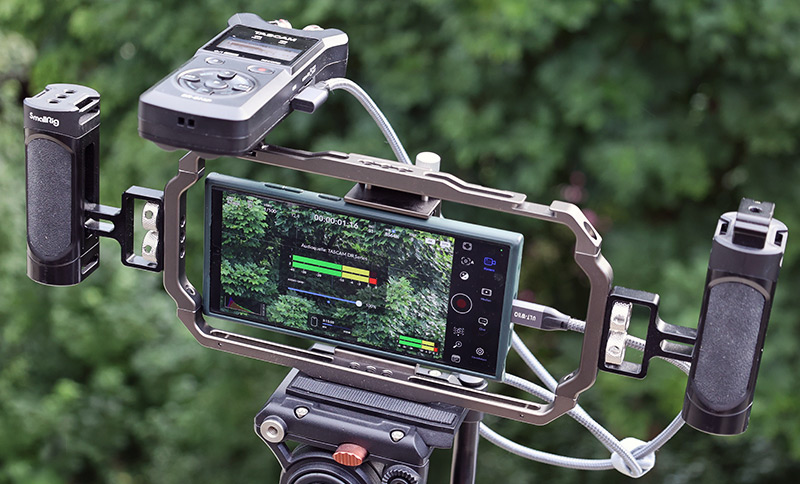
According to Tascam, support for Android systems cannot be guaranteed, unlike Apple iOS. However, the connection worked perfectly with the Samsung S23Ultra in our test. The DR-07XP was easily recognized as an external microphone in the DaVinci Resolve video app and worked without any dropouts in all recording sessions.
The sound quality of the recordings was pleasingly detailed for the intended use, such as podcasts, original sound for video clips in A/B microphone configuration, and nature recordings in X/Y configuration, with low noise levels. However, the DR-07XP was more susceptible to wind noise during outdoor recordings than the DR-05XP. Even activating the low-cut filter didn't help much here. A removable windscreen should be included with the recorder, but Tascam only offers it as an optional accessory (WS-11), presumably for cost reasons.
Otherwise, highs and lows were recorded in a balanced and natural way. Thanks to 32-bit float technology, dynamic passages with percussion or lively lectures could be processed on the computer without distortion, so that the autoleveler, which is unobtrusive in the best sense of the word, was not needed at all. During testing, I noticed a positive feature in relation to radio wave interference from cell phones or microphone transmitters. Unlike its predecessor, no interference was audible - even when, for example, an activated smartphone was placed one to two centimeters away from the device. In addition, the runtime with its own battery pack of over 14.3 hours in 32-bit/96 kHz mode was impressive, enabling long-term recordings in high quality.
I also found details such as the automatic microphone alignment prompts practical: depending on the change in microphone capsule arrangement, for example from A/B to X/Y, a menu appeared on the display asking for confirmation of the new microphone position to avoid “twisted” L/R recordings. Or the button handling to prevent unwanted recordings: pressing the record button once allows for manual level adjustment of the microphone input and headphone output, and the flashing record LED indicates that the device is ready to record. The recording starts only after pressing the record button twice, and the LED lights up continuously as a visual confirmation.
Conclusion
It's amazing how easy it has become to make good audio recordings with inexpensive equipment. The Tascam DR-07XP stereo audio recorder costs around $165, while the slightly more compact DR-05XP is available from specialist retailers for around $130. Tascam is thus continuing its tradition in the lower price segment by offering handy and, in the best sense of the word, no-frills mobile recorders for a wide range of applications, either solo or in conjunction with cameras or iOS smartphones: whether as a compact recording option for musicians, boom microphone use for content creators, or as a flexible recording device for nature recordings - thanks to the long battery life of over 14 hours, clear menu navigation, and 32-bit float technology, high-quality audio recordings can now be made quickly and anywhere.
By the way, a video about the DR-07XP is also available on proaudio.tv: www.youtu.be/70zVRMWHkwo
 How to resolve AdBlock issue?
How to resolve AdBlock issue? 